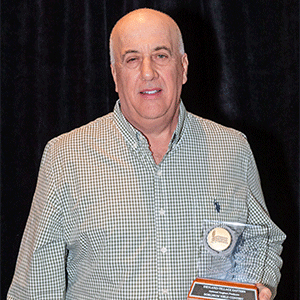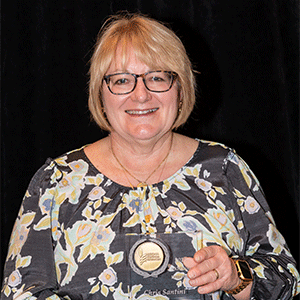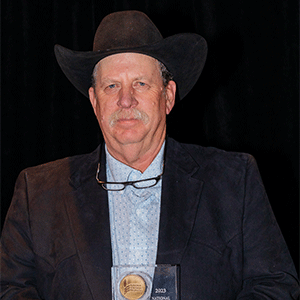
Swipe For More >
How Yield Champions Are Made
Meet the Top Winners of the 2023 National Sorghum Producers Yield Contest
What were the secrets to success for the 2023 Sorghum Yield Contest champions? From capitalizing on timely rains, trying new varieties and tailored input application the best of best found yield success in a variety of ways.
In the 2023 National Sorghum Producers Yield Contest, a diverse group of farmers across the United States showcased the resilience and potential of sorghum under varying climatic conditions. Learn about the steps these winners took to take home top honors in the 2023 contest.
DRYLAND-TILLAGE EASTERN
First Place: Santino Santini
Warren County, New Jersey
Variety: Pioneer 85P58
Yield: 221.06 bpa
DRYLAND NO-TILL EASTERN
First Place and 2023 Bin Buster: Chris Santini
Warren County, New Jersey
Variety: Pioneer 85P58
Yield: 221.75 bpa
Santino and Chris Santini, from Warren County, New Jersey, are a husband and wife duo, both securing victories in the 2023 National Sorghum Producers Yield Contest. Santino won first place in the Dryland-Tillage Eastern Division with a yield of 221.06 bushels per acre, using Pioneer 85P58. Chris took top honors in the Dryland No-Till Eastern Division with a yield of 221.75 bushels per acre, same variety, which also earned her this year’s Bin Buster award for the highest yield in the contest.
Santino planted 15-inch rows with 155,000 seeds per acre on his winning yield contest plot, which was planted to corn the previous year. He put down 350 pounds of N and 200 pounds of K, alongside herbicide and fungicide treatments, ensuring optimal crop health. Chris also planted 15-inch rows with 130,000 seeds per acre. The previous crop was soybeans. She applied 6,000 pounds of manure with the addition of herbicide and fungicide treatments.
Despite initial dry weather, late season rains helped their sorghum flourish. The Santinis said they also believe unforeseen influences, like the Canada wildfires smoke, enriched their sorghum crop with essential nutrients, contributing to their success. During harvest, the Santinis said their goal is always to surpass the 200-bushel-per-acre benchmark. Santino noted, “When we get any more than that, it’s a good year.” Theirsorghum is marketed toward premium bird seed markets.
Both Chris and Santino were inducted into the National Sorghum Yield Contest Hall of Fame this year in their respective winning divisions.
DRYLAND-TILLAGE WESTERN
CATEGORY
First Place: David Knoll
Charles Mix County, South Dakota
Variety: Pioneer 89Y79
Yield: 183.32 bpa
Charles Mix County, South Dakota, producer David Knoll was the winner of the 2023 National Sorghum Producers Yield Contest Dryland Tillage West division. Knoll had a yield of 183.32 bushels per acre utilizing Pioneer 89Y79.
Facing a notably dry growing season, Knoll’s farm had an estimated 10 inches of in-season rainfall, necessitating reliance on residual moisture from the preceding year. He said timely rains mitigated the impact, contributing to a successful yield.
Knoll planted 15-inch rows with a seed population of 110,000 seeds per acre, applying 100 pounds of N. His sorghum crop followed soybeans, and he managed typical grass and weed pressures, he said.
“Harvest was good because of low moisture, so it came out of the field dry, making it easier to combine this year than most years,” he said of his favorable harvest. “We didn’t have to fight any green or wet days or anything. So it matured fast.”
“It was way better than I expected for the amount of rain we had,” he continued, which secured his place in the National Sorghum Yield Contest Hall of Fame in the Dryland Tillage division, adding, “We were just blessed, again.”
DRYLAND NO-TILL WESTERN
CATEGORY
First Place: Mark Bloss
Pawnee County, Nebraska
Variety: Pioneer 84P72
Yield: 181 bpa
Mark Bloss from Pawnee County, Nebraska, emerged as the 2023 National Sorghum Producers Yield Contest Dryland No-Till West division winner. With a yield of 181 bushels per acre with Pioneer 84P72, Bloss made the most of a 2023 growing season that presented challenges with sporadic rainfall, abundant in July but scarce in August.
Bloss also faced dry soil conditions at planting due to minimal winter moisture, planting on 30-inch rows with a seed population of 144,000 seeds per acre. He applied 181 pounds of N and 52 pounds of P. His sorghum crop, following soybeans the previous crop year, experienced an estimated 16 inches of rainfall.
“I guess I expected good yields or decent yields for as dry as it was, but I didn’t expect them to be that good,” Bloss said. “It was a nice little surprise.”
Bloss credited sorghum’s resiliency, saying, “when the other crops started suffering once it stopped raining in August, the milo just hung in there. It was a good harvest.”
IRRIGATED EASTERN CATEGORY
First Place: Howard DeShong
Lancaster County, Pennsylvania
Variety: Pioneer 84G62
Yield: 168.34 bpa
Lancaster County, Pennsylvania, farmer Howard DeShong clinched victory in the 2023 National Sorghum Producers Yield Contest’s Irrigated East division with a yield of 168.34 bushels per acre with Pioneer 84G62.
DeShong planted 15-inch rows with a seed population of 140,000 seeds per acre. He applied 60 pounds of N, 6,000 pounds of manure and used a fungicide program. Corn was the previous crop. Like many other sorghum growing regions, DeShong was faced with early season moisture challenges.
“We had an extremely dry spring, then we had timely rains when we needed it,” DeShong said, “Then I have a little bit of irrigation there. That definitely helps.”
While DeShong had taken a break from growing sorghum, he was pleased to return it into his rotation despite heavy deer pressure in his area. “Fortunately, they ate everything else except for the sorghum.”
DeShong said the crop was a little lower than he expected, saying, “I think it was dry during the right period to just stunt the growth. Some of our chemicals didn’t get activated properly. We lost a bunch of nitrogen because we applied it then it didn’t rain early in the season.”
Despite these challenges, DeShong’s sorghum yield was strong enough to earn him the top place in his division. “I was happy. On a national basis, I was not expecting that.”
IRRIGATED WESTERN
CATEGORY
First Place: Bibb and Nighswonger Partnership
Comanche County, Kansas
Variety: Dekalb DKS44-07
Yield: 218.64 bpa
The Bibb and Nighswonger Partnership from Comanche County, Kansas, emerged as the national first-place winner in the 2023 National Sorghum Producers Yield Contest’s Irrigated West division. Their winning field saw a yield of 218.64 bushels per acre, using Dekalb DKS44-07.
Clark Bibb said they opted for 30-inch rows with a seed population of 85,000. The crop received 85 pounds of N (32-0-0) through irrigation during the season. He also applied 21 pounds of P and 39 pounds of K. The previous crop was soybeans.
Bibb’s farm, situated 60 miles south-southeast of Dodge City, Kansas, balances dryland and irrigated acres with sorghum proving itself as an effective component to his rotation, particularly in moisture-challenged conditions.
“I was a little surprised. It’s one of the circles that I don’t check, but my guys kept telling me it was looking really, really good,” Bibb said. “One of them took a picture of the young man that checks circles for me. He’s 6’4″, and it was almost up to his shoulders.”
Despite variable weather patterns, including a wet start followed by hot and dry conditions—and early-season herbicide leaching and weed pressures—Bibb said his contest field did better than he expected.
FOOD GRADE CATEGORY
First Place: JnL Farms
Appanoose County, Iowa
Variety: Richardson G37
Yield: 139.56 bpa
JnL Farms from Appanoose County, Iowa, took top honors in the Food Grade Division in the 2023 National Sorghum Producers Yield Contest. Joel Spring had a yield of 139.56 bushels per acre, using Richardson G37.
Spring said he dusted in his sorghum crop last year. “We waited three weeks for it to rain, which is very abnormal for us, especially because June is typically our wettest month,” he said. “And to go that long without any rain, it was weird planting like that.” Spring planted on 15-inch rows, using a seed population of 105,000 seeds per acre. The sorghum crop followed soybeans from the previous year, and inputs included 150 pounds of anhydrous, 50 pounds of P and 60 pounds of K.
“We had a few more weeds this year than normal, just because the herbicide laid there for three weeks, too,” Spring said, “so some of it didn’t get activated timely, but it was still minimal. I don’t feel that it hurt our yield at all. And then at heading, we sprayed a fungicide.”
Despite encountering a dry growing season, characterized by only two significant rainfall events, his sorghum crop defied his expectations. Timely rains in July and August led to a successful harvest. Spring’s sorghum is loaded on rail cars in south central Iowa and is transported to California where it goes into the gluten-free flour market.
Looking ahead, Spring anticipates expanding sorghum acreage and experimenting with longer-season hybrids for enhanced yields.
National Sorghum Producers is now accepting entries for the 2024 National Sorghum Yield Contest. The entry deadline is November 26, 2024. A complete field of 10 or more continuous acres, planted in the sorghum seed variety named on the entry form, will be designated as the contest field. NSP reminds growers, contestants are no longer required to wait 10 days after entering the contest to harvest. Contestants must harvest and report at least 1.5 continuous acres. Harvest reports will be made available to entered contestants beginning May 1, 2024, and all completed forms must be received at the NSP office no later than December 3, 2024. To find the entry form, 2024 yield contest rules and more information, interested growers can visit SorghumGrowers.com/yieldcontest, or contact NSP directly at 806-749-3478 or yieldcontest@sorghumgrowers.com.
###
This story originally appeared in the Spring 2024 Issue of Sorghum Grower magazine.


